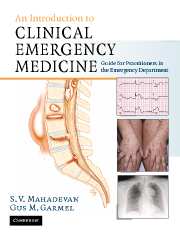Book contents
- Frontmatter
- Contents
- List of contributors
- Foreword
- Acknowledgments
- Dedication
- Section 1 Principles of Emergency Medicine
- Section 2 Primary Complaints
- 9 Abdominal pain
- 10 Abnormal behavior
- 11 Allergic reactions and anaphylactic syndromes
- 12 Altered mental status
- 13 Chest pain
- 14 Constipation
- 15 Crying and irritability
- 16 Diabetes-related emergencies
- 17 Diarrhea
- 18 Dizziness and vertigo
- 19 Ear pain, nosebleed and throat pain (ENT)
- 20 Extremity trauma
- 21 Eye pain, redness and visual loss
- 22 Fever in adults
- 23 Fever in children
- 24 Gastrointestinal bleeding
- 25 Headache
- 26 Hypertensive urgencies and emergencies
- 27 Joint pain
- 28 Low back pain
- 29 Pelvic pain
- 30 Rash
- 31 Scrotal pain
- 32 Seizures
- 33 Shortness of breath in adults
- 34 Shortness of breath in children
- 35 Syncope
- 36 Toxicologic emergencies
- 37 Urinary-related complaints
- 38 Vaginal bleeding
- 39 Vomiting
- 40 Weakness
- Section 3 Unique Issues in Emergency Medicine
- Section 4 Appendices
- Index
33 - Shortness of breath in adults
Published online by Cambridge University Press: 27 October 2009
- Frontmatter
- Contents
- List of contributors
- Foreword
- Acknowledgments
- Dedication
- Section 1 Principles of Emergency Medicine
- Section 2 Primary Complaints
- 9 Abdominal pain
- 10 Abnormal behavior
- 11 Allergic reactions and anaphylactic syndromes
- 12 Altered mental status
- 13 Chest pain
- 14 Constipation
- 15 Crying and irritability
- 16 Diabetes-related emergencies
- 17 Diarrhea
- 18 Dizziness and vertigo
- 19 Ear pain, nosebleed and throat pain (ENT)
- 20 Extremity trauma
- 21 Eye pain, redness and visual loss
- 22 Fever in adults
- 23 Fever in children
- 24 Gastrointestinal bleeding
- 25 Headache
- 26 Hypertensive urgencies and emergencies
- 27 Joint pain
- 28 Low back pain
- 29 Pelvic pain
- 30 Rash
- 31 Scrotal pain
- 32 Seizures
- 33 Shortness of breath in adults
- 34 Shortness of breath in children
- 35 Syncope
- 36 Toxicologic emergencies
- 37 Urinary-related complaints
- 38 Vaginal bleeding
- 39 Vomiting
- 40 Weakness
- Section 3 Unique Issues in Emergency Medicine
- Section 4 Appendices
- Index
Summary
Scope of the problem
Dyspnea is the perception of uncomfortable breathing and is synonymous with the terms “shortness of breath” or “breathlessness.” Other terms patients may use to describe dyspnea include “labored,” “heavy,” “difficult,” or “uncomfortable” breathing. Dyspneic patients often say they feel like they are being smothered, cannot catch their breath, or are unable to get enough air.
Dyspnea is a symptom associated with many disorders, from nonurgent to life-threatening. Like the perception of pain, dyspnea is subjective and its severity does not necessarily correlate with the seriousness of the underlying pathology.
The chief complaint “shortness of breath” is encountered in about 3% of all emergency department (ED) patients. Approximately two-thirds of these patients have an underlying cardiac or pulmonary disorder. Specific data on the general prevalence of dyspnea is not available, although in the Framingham study, 6–27% of the adult population reported experiencing dyspnea. In some patient populations (e.g., oncology patients), the prevalence of dyspnea may be much higher.
Pathophysiology
In general, breathing is a well-synchronized, unconscious, quiet and effortless process. Dyspnea results when ventilatory demand exceeds respiratory function. Although the exact mechanism responsible for dyspnea is unknown, abnormalities or alterations of gas exchange, pulmonary circulation, cardiovascular function, respiratory mechanics, or the oxygen (O2) carrying capacity of blood may result in dyspnea.
Respirations are generally “automatic” and under the control of the respiratory centers in the central nervous system (CNS) (e.g., medulla/pons).
- Type
- Chapter
- Information
- An Introduction to Clinical Emergency MedicineGuide for Practitioners in the Emergency Department, pp. 485 - 502Publisher: Cambridge University PressPrint publication year: 2005

